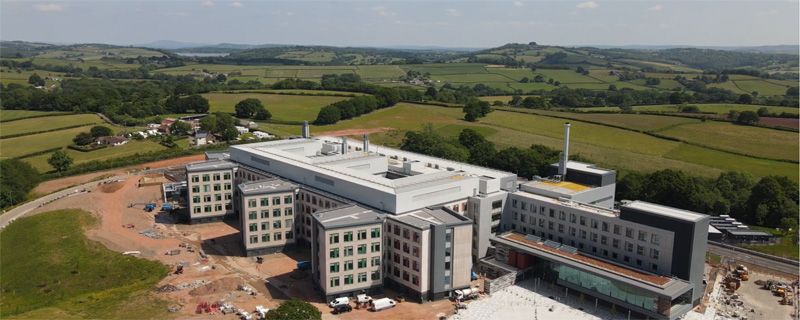The NHS in Wales built the Grange University Hospital in Gwent using MMC
A lack of progress on a ‘template’ to standardise hospital design across England is delaying the government’s hospital building programme, a report has found. According to the National Audit Office (NAO), the government will miss its pledge, made in Boris Johnson’s 2019 manifesto, to build 40 hospitals by 2030.
The NAO has analysed the New Hospitals Programme (NHP) and found that, by the definition set out in 2020, only 32 will be built in time.
It also raised concerns that, due to cost-cutting and inaccurate modelling of future demand, the new hospitals could be built too small.
Under plans to build hospitals faster using modern methods of construction (MMC), the NHP’s central team has been working since 2021 on designs for a new template, called Hospital 2.0.
Standardised designs for inpatient rooms, critical care units, outpatient rooms and an initial ‘kit of parts’ for MMC were supposed to be published in January, with a full design released later this year.
But the plans will now not be released before May 2024, after the NHP struggled with the ‘challenge’ of drawing up a modular hospital template, and found it hard to recruit technical staff, the NAO said.
In a bid to reduce cost overruns and delays, the new standardised approach aims to move the NHS away from its old way of working, whereby trusts developed designs on a ‘scheme-by-scheme’ basis.
However, the NAO said the NHP also had not ‘engaged meaningfully’ with the construction industry about key aspects of the programme and there were risks over whether the sector would have the capacity to take on the work.
The lack of design certainty was hampering the programme’s ability to project building cost savings, it said, adding: ‘Until Hospital 2.0 is finished, there are limits to NHP’s ability to make progress with planning schemes in cohort 3 and later.
The report also voiced concern that some of the new hospitals where design work had already been undertaken might need to be reworked to meet the NHP’s new standards.
Leeds Teaching Hospitals NHS Trust, one of the original Health Infrastructure Plan (HIP) schemes announced in 2019, had incurred over £10 million of design-related costs since 2018, which might ‘prove to have been fruitless’, the report said.
BDP won a contest to design the £600 million hospital, but the practice was later replaced by a rival bidder Penoyre & Prasad with Schmidt Hammer Lassen after the NHS trust said the practice was unable to proceed with the scheme.
The NAO report also highlighted how, unlike in new schools, Modern Methods of Construction (MMC) for hospital construction was not yet widespread in England.
The NHS in Wales built the Grange University Hospital in Gwent using MMC, which was completed under-budget and three months ahead of schedule, meaning it was available for the second wave of Covid-19.
But the NAO’s report said that, following the pandemic, there had been ‘challenges’ and that the Healthcare Inspectorate in Wales reported the waiting area in the emergency department at Grange University Hospital was ‘too small and unfit for purpose’.
The hospital was built on a greenfield site, but a particular challenge for NHP is that many of its schemes are on previously developed sites. The report said this means that standard designs will sometimes be implemented at constricted and irregularly-shaped locations.
Fears were also raised about the modelling used in a ‘minimum viable product’ version of its high-level Hospital 2.0 specifications. The NAO said some of the NHP’s underlying assumptions may result in hospitals that are ‘not big enough for future needs’.
When the Department of Health and Social Care (DCSC) officially set out the hospitals plan in October 2020, eight hospital construction projects already under way were not included in the target.
But recent government statements about building 40 new hospitals include these eight projects, referred to as ‘legacy hospitals’. In addition, last month, the government announced that five more hospitals would be added to the new build programme, due to risk of structural collapse because of weak concrete.
Meg Hillier, a Labour MP who chairs parliament’s Public Accounts Committee, said there had been a ‘woeful lack of progress’ on hitting new hospital targets, which the government was now trying to change.
‘The Department of Health and Social Care has been trying to move the goalposts so it can claim it has met its target,’ she said in a statement.
‘Patients and clinicians are going to have to wait much longer than they expected before their new hospitals are completed.’
Gareth Davies, the head of the NAO said: ‘The programme has innovative plans to standardise hospital construction, delivering efficiencies and quality improvements.
‘However, by the definition the government used in 2020 it will now deliver 32, rather than 40, new hospitals by 2030.
‘Delivery so far has been slower than expected, both on individual schemes and in developing the Hospital 2.0 template, which has delayed programme funding decisions.’
In response, a DCSC spokesperson said: ‘The NAO’s report acknowledges that despite changes to the original programme to prioritise hospitals affected by RAAC, 40 new hospitals will still be delivered by 2030, and praises the programme’s innovative plans to standardise hospital construction, deliver efficiencies and improve quality.
‘We remain firmly committed to delivering these hospitals, which are now expected to be backed by over £20 billion of investment – helping to cut waiting lists so people can get the treatment they need quicker. Three new hospitals have already opened and more will open this year so patients and staff can benefit from major new hospital buildings, equipped with the latest technology.’





Leave a Reply
Want to join the discussion?Feel free to contribute!